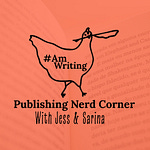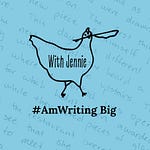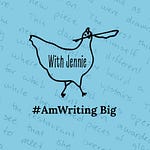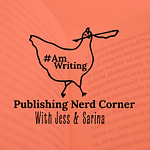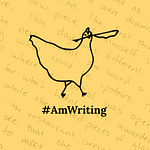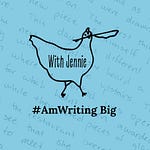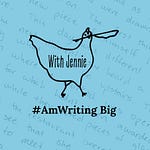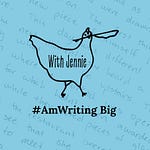
And you thought our shelves full of self help books were just to manage our own issues! Nope, there’s another use for them. Our guest this week, Kathleen Smith, is a therapist and writer and the author of Everything Isn't Terrible, a helpful and humorous guide to shedding our anxious habits and building a more solid sense of self in our increasingly anxiety-inducing world. It’s very useful, and we’re valiantly attempting to tame our own anxieties—but that’s not (much of) what we talk about. Instead, we’re focused on what’s really important—and within our control: Creating believable, dysfunctional characters and then helping them to grow and change.
We talk about romance dynamics: the pursuer and the pursued, the over-functioner and the slacker—and how important it is that a couple be at a similar level of maturity (or, more likely, immaturity) to be believable. From there, it’s headlong into siblings, birth order and circumstance, family coping mechanisms and some of the ways to develop deeper conflict within our work. It’s such a great conversation.
Episode links and a transcript follow. Thanks for being with us! If you love the podcast, tell a friend. Right now. Just drop everything and go sit someone down and make them listen. And if you love the podcast, you can support it! There are perks. #SupporterMini episodes. #WriterTopFives.
LINKS FROM THE PODCAST
Genograms: Assessment and Intervention
Family Constellation, Walter Toman
#AmReading (Watching, Listening)
Kathleen: Bringing Down the Duke, Evie Dunmore
KJ: Ex Libris, Anne Fadiman
The Uncommon Reader: A Novella, Alan Bennett
Sarina: 19 Love Songs, David Levithan
Our guest for this episode is Kathleen Smith, author of Everything Isn't Terrible: Conquer Your Insecurities, Interrupt Your Anxiety, and Finally Calm Down. For more:
Website - KathleenSmith.net
Twitter - @fangirltherapy
Instagram - @kathleensmithwrites
Free Anxiety Newsletter - https://theanxiousoverachiever.substack.com/
This episode was sponsored by Author Accelerator—training book coaches and matching coaches and writers.
Find out more: https://www.authoraccelerator.com/amwriting.
Find more about Jess here, Sarina here and about KJ here.
If you enjoyed this episode, we suggest you check out Marginally, a podcast about writing, work and friendship.
Transcript (We use an AI service for transcription, and while we do clean it up a bit, some errors are the price of admission here. We hope it’s still helpful.)
KJ (00:01):
Hey listeners, KJ here, if you're in with us every week, you're what I like to call people of the book. And some of us book people discover somewhere along the way that not only are we writers, we're people with a gift for encouraging other writers. Maybe that comes out in small ways for you, but for some of you it's a calling and an opportunity to build a career doing work you love. Our sponsor, Author Accelerator, provides book coaching to authors like me, but also needs and trains book coaches. And if that's got your ears perked up, head to authoraccelerator.com and click on become a book coach. Is it recording? Now. It's recording.
Jess (00:44):
Now it's recording.
KJ (00:44):
Yay!
Jess (00:44):
Go ahead.
KJ (00:46):
This is the part where I stare blankly at the microphone, trying to remember what I'm supposed to be doing.
Jess (00:50):
Alright, let's start over.
KJ (00:51):
Awkward pause. I'm going to rustle some papers. Okay. Now one, two, three. Hey, I'm KJ Dell'Antonia and this is #AmWriting. #AmWriting is the podcast about writing all the things - short things, long things, fictional things, non-fictional things, something in between kinds of things, which I don't know that we really recommend, it depends on where you're writing for. But in any case, as regular listeners know and any new listeners are about to find out, this is the podcast about figuring out how to sit down and get your work done.
Sarina (01:30):
I'm Sarina Bowen. I only write long things and fictional things. I'm the author of 30-odd romance novels and my newest one is called Heartland. You can find all about it at sarinabowen.com.
KJ (01:46):
I feel like the things that we write are feeling particularly long this week. I don't know about you, but I feel like I only write really long things that somehow don't have enough words. Yeah, but they sure feel long to me. I am KJ Dell'Antonia. I am the author of my first novel, my debut novel, is The Chicken Sisters coming out in June of 2020 and I'm also the former lead editor and columnist for the New York Times of the Motherlode and the author of How To Be a Happier Parent, which is out in hardback now and will be out in paperback this summer.
KJ (02:20):
And I am delighted to say that we have a guest today. This is going to be a really fun, if somewhat fictionally focused episode. Today we are joined by Kathleen Smith, a therapist and writer and the author of Everything Isn't Terrible: A Helpful and (I can vouch for this) Humorous Guide to Shedding Our Anxious Habits and Building a More Solid Sense of Self in Our Increasingly Anxiety Inducing World, which is brilliant. And we love it. And we are working away at our own anxieties. But we've actually asked Kathleen here today to talk about the anxieties we have more control over - the anxieties of our fictional characters. In other words, we're going to talk about creating believable, dysfunctional characters and families and then helping them to grow, and change, and get better. Welcome.
Kathleen (03:12):
I'm so excited to talk about this topic with you guys. Thanks for having me.
KJ (03:16):
Thanks for suggesting it and coming. We think this is fantastic. It's so funny because as I read, Everything Isn't Terrible and I have been, I sort of flick between, Oh wait, I need this. Oh wait, my character needs this. Oh wait, I do this with my mother. Oh wait, does my character? I think I need to read it twice, once in each guise. So how did you think of the idea of using a therapeutic formula, a therapeutic lens to view fictional characters?
Kathleen (03:54):
First of all, I'm a huge fan girl and I love reading books and watching TV shows with complex families. Right? You know, everyone these days is obsessed with succession, right? Or the crown or these sort of glamorous, dysfunctional families. But as a therapist, I'm a firm believer that everyone's family is just as interesting. You know, if you'd sorta take a dive in and look at the rich sort of emotional history of a family. So I love seeing it in real life and I love seeing it in fiction, too, especially when it's done really well.
Sarina (04:30):
Which fictional families in print have you enjoyed recently? I was so curious about this.
Kathleen (04:36):
Yeah. Well one thing I'm reading right now is I'm rereading Emma because you know, the new movie is coming out. So it's interesting to see some of the family dynamics in that. And you know, sibling position. And I think Jane Austen in particular does such a wonderful job bringing out those differences and the dynamics of people. So that's one thing I'm enjoying right now.
KJ (05:00):
You used another Jane Austen example with us, which was just sort of to get right deep into it, you were talking about how spouses tend to be at the same level of emotional maturity, even though they might express it differently. And you gave the example of the Bennetts in Pride and Prejudice. And that just made me laugh because I've read Pride and Prejudice many times, but also multiple recreations of it, recently. That happens to be a trope that I love and yes, absolutely. I'd never thought of it that way, but they're both equally awful. It's just that one of them is awful in a more appealing kind of way.
Kathleen (05:41):
Absolutely. You know, and I think we like to think that we're more mature than our spouses, but at least the theory I was trained in, that is not the case. We tend to be attracted to people who are at the same level of emotional maturity. So I think that's important to think about when you're creating characters, and a marriage, or in a relationship. What that kind of reciprocity is and how that sort of fits together. Like just you said though, one person might be seen as the problematic one, right? But that's often not the case.
KJ (06:12):
We are going to think of this firmly from a fictional perspective and yeah, let's dig into that. So we've got maybe we've got two romantic leads and we're seeing one of them as the problem, you know, one of them is not returning phone calls or is not living up to expectations, but it's important that they both have sort of equal level of flaws is what I'm hearing you saying.
Kathleen (06:40):
Yeah. I mean you could have, and this is such a classic relationship thing, you could have one person who's the distant one, right. And then one person who is sort of the anxious pursuer and we interpret one as necessarily having the problem, but they're both caught up in this sort of anxious dance of trying to relate to one another. Or trying to get away from the anxiety. Or another classic example is like one person is an over functioner, right? And they take on all the responsibility and do everything and the other person is seen sort of as a slacker, right? Or the lazy one, but they're just responding to the other person's behavior. So, it's definitely a two person dance.
Sarina (07:20):
This also makes me think of a trope that I see in romance all the time that I'm not a huge great fan of, which is the crazy ex. Sometimes you get sort of cheap conflict in a romantic plot arc because somebody has a crazy ex, but it's really hard to write a good crazy ex without painting your hero or heroine as kind of an idiot for staying with that person in the first place.
KJ (07:48):
Oh, good point. Yeah.
Kathleen (07:51):
It doesn't make any sense to have them be sort of at different levels of functioning. They probably wouldn't have been together in the first place if that were the case.
Sarina (07:59):
Yeah. I mean, you can always make a case for somebody experiencing a lot of growth since they originally got together with that person. But yeah, it's hard. One time I was writing a book three with my collaborators and we already knew from books one and two who the hero and heroine of book three were. And this romance had a lot of potential already. But we realized as we were sitting down to plot it, that both characters came from really wonderful, stable families and we sort of looked at each other and went, 'Oh, we're in so much trouble.'
KJ (08:39):
Yeah. Let's talk about how that family background matters. I mean, why can't we create a book around two people from wonderful, stable homes who've been supported, and loved, and had only good experiences all of their lives? Besides because they don't exist.
Kathleen (08:56):
Well, you know, in my book I use that well-known Mary Carr quote that a dysfunctional family is any family with two people in it. Right? Or it's something like that. So I don't know if such a thing exists, first of all. You know, there's always some amount of anxiety and dysfunction in any family, but you know, it's much more interesting and it's much more rich to sort of go back a generation or two and ask yourself what are the processes that work here, you know, is this a family that avoids each other in distances and that's how they deal with everything. Is this a family that cuts people off the second they disagree with them or do something scandalous? Or is this a family who's all in each other's business and is constantly doing things for people that they can do for themselves? You know, it's interesting to think about what some of those patterns might be and then all of a sudden you have kind of set the stage for your character to kind of emerge from that. And that can influence then how they are in their romantic relationships, or in their work, or with their own family. So just by doing that sort of homework ahead of time, you have such a great jumping off point for creating conflict and plot.
Sarina (10:08):
Sometimes it feels like it's really hard to do that ahead of time and you have to kind of wade in first.
Kathleen (10:14):
Yeah, I mean I think that's why it's useful to know your own family really well, first of all. It can be an inspiration or other people's to kind of get you curious about that. But you know, just taking the time to kind of draw that out and draw a little diagram or just some, some facts can be really useful.
KJ (10:34):
Well, you suggested four different sort of family patterns, let's talk about those and how we might be able to use them in fiction.
Kathleen (10:42):
The first one is distance. That's sort of the most obvious things that we do as humans when we're nervous, or upset, or stressed, right? Like we just get out of there as quickly as possible. But there's also emotional distance, right? So as a family, only talking about the weather, or sports, or very superficial things as a way of managing sort of the underlying anxiety. And then the second one is conflict, which is a little weird because at first glance you don't think, well, conflict doesn't manage anxiety, right? Like doesn't that cause anxiety? But if I'm convinced that someone is wrong all the time, then that calms me down a little bit. It's actually adaptive. So a lot of families use conflict and sort of focus on one person as the problem. To calm them down. And I think that's so useful in fiction because it sort of helps you see that just the person who is identified as having the problem isn't the only player here. Right? Everyone is contributing to that in their own way. And you want me to keep going?
KJ (11:49):
No, I'm thinking about that. The conflict one. I think it kind of goes back to what we're talking about in a romantic relationship where from a fictional point of view, you can draw a picture that looks like one person is the problem. And what is going to evolve is that the people who are making that person the problem are also the problem.
Kathleen (12:16):
Exactly. Everyone is contributing. Right? And I think that's a good point is you can't look at a person sort of and tell how mature they actually are. Because you know, everyone is sort of propping up other people and so one person in a family might be doing really well and they might have a stable job and seem like a healthy person, but it's because they're directing all their attention onto fixing a kid. Right? Or a sibling or a parent. It all sort of gets diverted to this one per person who gets identified as the problem. So that's what's so great about humans is we're just such tricky, complex creatures you can't necessarily take at face value, how mature a person is and how they're going to act in crisis people who are actually much less mature than we think we are.
KJ (13:10):
And how does that dynamic play out on the other side, the person who is sort of constantly being fixed?
Kathleen (13:16):
Yeah, I mean it's sort of - we're getting into Jess territory with her writing about parents focusing on kids. But you know, the idea is that if you tell a person that there's something wrong with them or there's something to be anxious about, they start to believe it. So it's useful for them to fall into that role and to play that role to kind of keep things stable. But that doesn't mean that they won't have problems, you know, they might develop more of the symptoms or more of the problems because everyone in that family is anxiously focused on them.
KJ (13:50):
So what I'm hearing is that it's worth, like everyone in the story is invested in keeping the status quo, even if the status quo is crappy.
Kathleen (14:00):
Yes. And that's such a great plot turning point as well, because if that person gets sober, or starts doing better, or acts differently, it throws everybody off. You think that they want the person to get better, but then they start doing things differently, and it changes the whole system. It changes all of the dynamics. And so that's such an interesting thing to play around with when, okay, what if the person who is seen as the problem child or the problem spouse starts doing better? That is a great sort of turning point for shaking things up because people don't like it. They will push back, you know? And it's just really fascinating to see or to read about.
KJ (14:45):
Okay. So that was two dysfunctional family tropes. What else you got?
Kathleen (14:50):
Yeah, well, the other one is very classic. It's overfunctioning and underfunctioning. And so this plays out a lot in marriages especially, but can also with parents and kids, or with siblings. You know, who is the person who is becoming over responsible in times of stress, right? They are doing things for others that they could do for themselves. You know, and who was the underfunctioner, they're letting the other person take on that responsibility and that sort of ends up - you know, the underfunctioner is often a person who might develop substance abuse problems or other issues because they're sort of in that one down position. And so, you know, based on your sibling position, right? Like, so if your mother was an overfunctioner and her mother was an overfunctioner, you know, you're really gonna get it, right? If you're the first born, that's probably going to be your role. Or if you had a parent who was always overfunctioning for you, you might be a little bit less capable. And so that's kind of an interesting thing to play around with. And if you're looking at a family, you're creating and saying, okay, who are the overfunctioners here and how did they get in the way of everyone else growing up a little bit?
KJ (16:07):
Does it work like horoscopes where overfunctioners are more likely to be drawn in relationships to slackers or are they drawn to other overfunctioners or could it just be anything?
Speaker 4 (16:22):
Oh no. Yeah, it's reciprocal. Right? So it's the two people participating in the dynamic.
KJ (16:29):
So you might have an overfunctioner within their family and they're drawn to someone who's an underfunctioner within their family?
Kathleen (16:36):
Well if you're talking to a romantic relationship?
KJ (16:39):
Yeah, I was talking about a romantic relationship.
Kathleen (16:40):
Definitely, that works a lot. Two overfunctioners are probably gonna butt heads a lot. So you could still write that in a romance. Absolutely. But it would be an added challenge because both people are trying to care for each other, and help each other, and that causes issues.
Sarina (16:56):
That sounds fun to me actually. Like the butting heads is often a really terrific romantic conflict.
Kathleen (17:05):
Absolutely. And if we're going to talk about siblings later too, that's another thing. If you have two oldest children, they're probably gonna be that way. So it's an interesting dynamic. But yeah. So if we want to move on, the fourth one is triangles. And everyone knows about triangles, right? It's human nature when two people are tense to pull in a third person or to focus on a third person to calm things down. So it's not just a love triangle. It's sort of the ways that we use other people to calm down our relationship with another person. And those are fun if you're drawing a family diagram to sit down and ask yourself, what are the triangles in this family? Is it two siblings against parent? Is it a parent who's using a sibling to talk to another sibling? You know, is it two parents and a child? The example I love to give - it's from television, but you know, everybody's pretty familiar I think with the show Everybody loves Raymond, it's been awhile since it was on, but I think most people are familiar with it - and there's this classic triangle in it between the mother-in-law Marie, the son Raymond, and the wife Deborah. And everyone thinks that the conflict is between Debra and Marie, right? The mother-in-law and the daughter. But you know, Ray is actually (whether he realizes it or not) is actually quite manipulative because he is able to stay out of the conflict by putting it on the two of them. But, you know, his stance is, Oh, this issue is between you guys. But he's actually contributing to it by being a part of the triangle and by saying he has nothing to do with it. And so it's so interesting to kind of play around with and see how these dynamics with three people could be interesting because - the idea is that when two people are getting along, the third person feels like they're left out and they'll try and butt in and cause conflict. But if two people are having a fight, the third person doesn't really want to be involved in it. The safe place is kind of on the outside. So that's just another fun family dynamic or relationship.
KJ (19:20):
Or you might have a third person who is trying to fix it. Or a third person who's trying to make it worse.
Kathleen (19:26):
Yeah, absolutely.
KJ (19:27):
Yeah, I think it's neat. This is an interesting thing to think of from official perspective because I feel like we often sort of have a conflict, or a plot point, or something that's happening and we've only looked at the point of view of maybe the two main players and to always think, well who's the third player here? That's a different approach.
Kathleen (19:49):
Yeah, absolutely. And who's maybe trying to give them advice or calm things down. And it can be a positive thing. It's not necessarily negative, but there's usually always more than two people involved when there's conflict.
KJ (20:03):
So it sounds like from there we should start, you know, taking a look at the siblings in our people's relationships, even if we weren't thinking of a sibling as a big player in a plot. It sounds like we better know who the siblings are and how they play out.
Kathleen (20:19):
Yeah. And that's one of the most interesting questions you can ask is what is the person's position in their family? And how does that inform how they are in all other relationships? You know, sibling position is definitely a part of it. There's actually this other cool book I would recommend to listeners. This guy named Walter Toman in the 60s did this huge study where he interviewed people about their sibling positions and he wrote this book about what other people they would match well with in a romantic relationship, and who they'd be friends with, and who they'd get into fights with, and sort of what their careers would be. You know, it's such a cool resource. The only issue is it was written in the 60s, right? So it's only talking about straight couples and women aren't assumed to have careers. So you kind of have to take that into account when you're reading it, but it's almost like kind of reading a horoscope in a way. It's just so interesting to me because I love reading them to people to see if their spouse or other people in their life match with it based on this description.
KJ (21:28):
So what is the book?
Kathleen (21:29):
It's called Family Constellations.
KJ (21:32):
It sounds very horoscope.
Kathleen (21:35):
It does, right? But it's interesting, you know, the idea is that oldest and youngest tend to pair well together. You know, oldest and oldest tend to butt heads a little bit. And youngest and youngest kinda just faff about and don't know what to do a lot. So and obviously there's a lots of exceptions and lots of happy marriages despite these things, but it can play a role, you know, and so it's interesting to read these and think about whether they could be useful when you're creating characters. And yeah, it's just an interesting resource I would recommend to people. But it's not just your sibling position, it's what was happening in your family around the time you were born. So, on a serious note, say like a woman had had a stillbirth or multiple miscarriages right before the birth of a child, that child is probably going to get a little bit more of an anxious focus when they're born. Because of all the things, or if there's just been a death in the family, right? There's just more anxiety in the air. And so they might have a little bit of a harder time kind of growing up and being an individual because that is sort of one extra challenge that they have. Or is it a younger sibling and the parents are a lot older and so they're just kind of doing whatever and are more sort of Laissez Faire in their parenting. Or is it six boys and one girl? How was that girl treated differently in the family and how is her role different? And it's not just the sibling position, it's your parents' sibling positions. I mentioned this earlier, like if this is the oldest of an oldest of an oldest, right? They're really gonna like to be in charge and they're probably going to be an overfunctioner. And it's just interesting to kind of play around with it and think about those positions.
Sarina (23:32):
You know who I feel is really good at writing these relationships is a novelist, Kristin Higgins. She uses siblings a lot, and she does this wonderful thing where she is able to use all of this family position stuff. And then at the end of the books, avert it, so that the sister that you weren't expecting to really be there in the clinch, is the one who makes the difference.
Kathleen (24:02):
That's really interesting.
Sarina (24:03):
Yeah. But she does it in a very believable way. So it's not as if she's throwing away those tendencies, but rather, you know, the exception proves the rule kind of manipulation. It's pretty neat.
KJ (24:16):
Well, that's kind of the point of what we're trying to do here is to see where our characters start out and then pull them to a different place. Right? So we want the character who maybe without sort of saying it in so many words, but who looks at their distancing relationship with their family and goes, okay, I'm going to stop hiding, I'm going to stop not talking. I'm gonna change and grow. And yeah, it's the relationships with the other people around them, but ultimately, it's that protagonists, you know, where they start and where they end that matters for the story.
Kathleen (24:58):
Yeah, absolutely. And I think that's a good question to ask. If you're thinking about, okay, how do I create a disruption too - is anytime someone is doing the opposite of what they would normally do to calm things down, that's when you get the shakeup, that's when you get the initial pushback, right? Like it might help things in the long run, but temporarily it's going to increase the anxiety and maybe increase the conflict a little bit. So that's a wonderful question to ask is what does my character normally do in stressful situations or when they are anxious and can I create a situation where they do the opposite and what is everyone's response to that? How does everyone sort of turn on that moment? And I think that's an interesting way to kind of play around with creating a little bit of conflict in a family.
Sarina (25:48):
Yeah, you went into this in your book, Everything Isn't Terrible, I can't remember which example, but when somebody finally started having more productive responses to the two less functional people in their family it freaked everybody out and made everything harder immediately, even though it was the right course of action and eventually got there. But you're right, that's a nice plot drama.
KJ (26:19):
So something else you also mentioned was drawing this out and you use the word genograms and you triangles. And I think we're getting this picture of family trees and geometry. And how might that work? What can we draw?
Kathleen (26:36):
Well, you know sometimes it's called a family diagram. Sometimes it's called a genogram, but basically it's sort of a family tree that has the facts, but also has the sort of emotional processes. I recommended one book, it's called Genograms by Monica McGoldrick. It's the one that's sort of used when people take a family therapy class in grad school. But you know, you can come up with your own symbols. It doesn't have to be the same technique, but you know, if you're drawing conflict, drawing little lightning bolts, right? Or if there's cutoff, you draw a line and then another line that's perpendicular to show that gap, right? There's lots of different ways that you can do it, but it's sort of mapping the emotional history as well. Looking at the triangles, you know, drawing just a triangle between three people. And sort of looking at how that, but also the facts of the family, can kind of inform you as to how people act. Because I think that's useful to write down, you know, when do people die? What else was happening at the same time? When were people born? When did people get married? You know, did a bunch of people get married after the death of a parent? Like you see that a lot of times in families. Or are there missing relatives or branches of a family tree that are sort of just big question marks? There's something about being able to see that on paper drawn out that really just adds another layer of complexity to thinking about the family. And I think it's such a useful tool to have as a writer. And maybe if people are inspired they can do it with their own family. But you don't know what you don't know until you draw it out. And I think it's useful to see what facts are missing. You know, do you not know about people's careers, or their education level, or illnesses, or substance use issues, or where people lived, when they immigrated. Those are all useful facts to know.
KJ (28:45):
Right. And you can get a long way in fiction without knowing everything about your person. And you can also get a long way down a rabbit hole by trying to write out everything about the person. But you know, every time I create someone, and this is going to be more true for Sarina because she's done it more, it's amazing how much I need to be able to go back and go, okay, wait a minute. I mean, I can't even name them until I know who their parents are. So right away, you're thrown right into it.
Kathleen (29:27):
Absolutely. And I think, you know, you don't have to have all of the information for every character, but I think if a character is missing information about themselves, that's important too. That shapes who you are also. So it's not just what they know and what's available to them and what, you know, as the writer, it's what's unknown as well and how that influences people.
KJ (29:47):
Do you sometimes see authors sort of failing to take this stuff into account? Like are you reading along and you're like, wait a minute... You don't have to name names. I'm just curious.
Kathleen (29:58):
I think the example that Sarina gave about the crazy ex was such a good one, because I think what I see the most is just this incredible mish-mash and sort of lopsidedness of maturity and functioning, when we don't operate that way as humans. You see this a lot in literature, someone has a really terrible parent and then they're this just this angel, right? Like we paint things as heroes and villains. And it's much more complex than that. And so I think doing some of this thinking keeps you from falling into the trap of good person, bad person, victim, hero, villain, right? Not that there aren't terrible people, but I think it just adds so much more to the story when you're able to see the interaction between people and when you see the family as the unit and not just the individual. It helps you make people much more relatable, even if they're maybe not the greatest person in that story, but they're not just a straight up villain.
KJ (31:09):
Right. You have to know where all that stuff comes from.
Sarina (31:12):
I think my downfall is sort of the opposite way. Like I write really cerebral characters who can usually find the right way and then I turn on the news and I'm like, wow.
KJ (31:22):
Plus it's a problem because you don't want - and I do this all the time too - I'm like, and then they calmly and rationally resolved the problem. Because to some extent I guess you're writing what you would like to see happen, but it doesn't work. We need them to not calmly and rationally resolve the problem.
Kathleen (31:51):
Well I think the only other thing I would add, and you know I talk a lot about this in the book, is that I think it's important to remember that people do what they do to calm things down to the best of their ability. People aren't just randomly throwing in bombs to shake things up necessarily. And we know we've evolved that way for a reason, and it might seem very strange, or upsetting, or annoying to you, but if you can see it as sort of an adaptive thing that that person does to deal with things the best that they know how, I think it allows you to be a little bit more empathetic towards that character and add a little bit more to that character than to someone who's just dropping in to wreak havoc. They're actually doing what they have been programmed to do as a human to try and get through a challenge.
KJ (32:40):
It's just important that it be wrong.
Sarina (32:43):
Yeah. That sounds like a fun way to write a drama llama sibling.
Kathleen (32:47):
Yeah, absolutely. You know, how has this become a person's way of dealing with the chaos?
KJ (32:55):
There's gotta be a reason why they are the way that they are. Well that is so helpful. And it is a different way to think about it and also a chance to broaden and deepen what we're creating in our fiction. And I I don't think we should miss those. So this was really good. I like it. This is fun, and smart, and a great way to sort of create the dysfunctional family that you can manipulate as opposed to living in the dysfunctional family that you're kind of stuck with. Well, this is the part where we like to talk about the dysfunctional families that we're reading about, or functional, or whatever. And I forgot to warn you, but I know that you listen all the time, so hopefully you knew that we were going to ask you if you'd been reading anything good lately.
Kathleen (33:57):
Yeah, I actually have. Since my book has come out, I'm just letting myself read only romance because that is just like a gift to me and it's something I don't do a whole lot. So I've just really been enjoying reading tons of romance. And one that I've really enjoyed recently is Bringing Down the Duke by Evie Dunmore. I don't know if you guys have heard of that one. It's part of her series she's writing called A League of Extraordinary Women and it's about women revolved around the suffrage cause in the U.K. And so it's just a really fun, great romance. And I recommend it.
Sarina (34:33):
You know, I haven't read her yet, but that book is getting a lot of chatter among my friends, so it's definitely on my list.
KJ (34:39):
I too had heard it. I think I heard it probably on Book Riot, which is a source of many, many book recommendations for me. Do not listen to the Book Riot podcast unless you have a large budget of disposable income to just go and buy all the books because that's what happens to me every single time. How about you Sarina? You read anything good lately?
Sarina (35:04):
I have a brand new book I'm about to start called 19 Love Songs by David Levithan. And David Levithan is a wonderful YA author who I have read, you know, pretty much everything he's written and this is a special anthology coming out right now, which is Valentine's day-ish because he is so wonderful that he's written some extra stories so I can't wait for 19 Love Songs.
KJ (35:35):
I'm just looking through what I've been reading lately and I've been reading a lot, like I have big stacks and then of course the minute I get on the spot and I'm trying to figure out what it is that I read and what I enjoyed, I can't, so I'm in the middle of something that I love, but I'm going to wait and talk about it when I finish. And I'm going to tell you all if you have not heard about it, I'm going to give you a pair of fun, fun books that I read. One was Ex-Libras: Confessions of a Common Reader by Anne Fadiman and it's just a bunch of essays about reading. And the delight of that was that I had it on my Kindle and I went to dinner by myself and foolishly grabbed only one book off of the stack of books that I had by the bed. And then the other thing that just reminds me of it is a book, I don't think I've mentioned it before, it's called The Uncommon Reader. And it's a novella by Alan Bennett. And it is the story of what happens when the Queen of England begins to take a passionate interest in reading. And it is hysterical, and beautiful, and wonderful, and very short. So I recommend it. And that's it. I guess that's our show today.
Sarina (37:12):
KJ, are you going to give a book away?
KJ (37:15):
I am, yes. Right now. Right now. What I wanted to say to everyone, I'm helpfully holding this up to the microphone so I hope you can all see the adorable copy. We're going to give away a copy of Everything Isn't Terrible by Kathleen Smith and you can read it for your own life and conquer your own insecurities, and not interrupt your own anxiety, and finally calm down, or you can pretend that you only need it for fictional reasons and try to figure out ways to get your characters to conquer their insecurities. We're doing both and we would love to give this away. And what I thought we would do is we will pull a name from our list of subscribers to the show notes. So if you are on our subscribers, if you get the podcast in your email every week, you are already entered. And if you don't then you should go to amwritingpodcast.com and sign up to get the show notes every week. And they are more than shownotes. It's always what we thought of the episode, and all the links, and all the books, and usually some bonus lunacy just because none of us is capable of writing anything straight up anymore. So that's the idea. Sign up. Maybe you'll get to win the book. Alright. I want to thank you, Kathleen. This was great and this was really fun. Where can people find you on all the social media and in all the places?
Kathleen (38:40):
Yeah, the main place is my website, Kathleensmith.net. I write a weekly newsletter called The Anxious Overachiever about my own efforts on myself and my work with clients that people might be interested in. Or they can catch me on Twitter at fangirltherapy.
KJ (38:55):
And the book again is Everything Isn't Terrible: Conquer Your Insecurities, Interrupt Your Anxiety, and Finally Calm Down by Dr. Kathleen Smith. Grab it. It is fun. And like I said, we can all just pretend that we're buying it for purely fictional reasons. That's our show this week. Yay. Alright, you want to take us out, Sarina?
Sarina (39:18):
I will and thank you both. And until next week keep your butt in the chair and your head in the game. This episode of #AmWriting with Jess and KJ was produced by Andrew Parilla. Our music, aptly titled unemployed Monday was written and performed by Max Cohen. Andrew and Max were paid for their services because everyone, even creatives should be paid.



